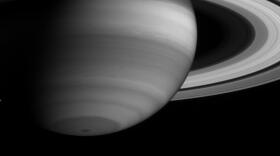-
Strange Universe With Bob BermanSo far this cold season, Earth's sister planet has heated up the evening sky like a UFO. You've surely seen that dazzling "star" soon after sunset: This has been its best showing since 2017. That eight-year interval is no accident. So happens, 13 of Venus’ years around the Sun have the same number of days as eight Earth years. They both work out to 2,922 days. Tune in to hear when you can see expect these special evenings.
-
Strange Universe With Bob BermanDo you want to understand climate change – really understand it – in under 3 minutes? Then pull up a chair. It all revolves around the trapping of heat, which is far simpler and more fascinating than people seem to believe.
-
Strange Universe With Bob BermanA lunation is the term for the Moon passing through all of its phases, which takes 29.5 days and was the basis for the calendar month. A lunation always begins with the New Moon, which will oddly happen the final days of the year, next week, guaranteeing unusual darkness for the upcoming New Year’s Eve. Tune in to hear some weird facts about the moon and the controversial statistics that indicate a bit more cloudy weather.
-
Strange Universe With Bob BermanIf someone you know has their head in the stars, here are some last minute gift ideas. Binoculars, which can provide mind-blowing images of the things like the Pleiades, star clusters, Andromeda Galaxy and the Milky Way.
-
Strange Universe With Bob BermanDo you or any of your friends know the most abundant element in your body is oxygen? Can you name the only major moon that does not circle around its planet’s equator? (That’s our own Moon). Have any idea that the average cloud weighs one million pounds? We’ll give credit to those who showed us the fundamentals.
-
Strange Universe With Bob BermanSaturn arrives at its closest point to Earth of the entire year. So let’s locate it. It’s the ONLY bright star in that entire section of the heavens. We’ll also discuss Saturn’s composition and its journey around the sun.
-
Strange Universe With Bob BermanOnce in a while, the sky offers a profusion of great beauty that happens to lie slightly below the limit of what the eye can see. That’s when you need a good pair of binoculars. Tune in to hear what phases of the moon you can expect to see.
-
Starting next week, the nearest star to the Moon will be the bluest of them all, which is Virgo’s brightest star, Spica. Hear why Spica, one of the brightest objects in the constellation of Virgo, is one of the 20 brightest stars in the night sky.
-
It’s time to have some serious sky-fun. This coming Tuesday and Wednesday evening, the nearest celestial bodies will perform some tight gymnastics for our enjoyment. You don’t even need unpolluted country skies — city streets will work for this one.
-
The universe’s four forces are identical everywhere. So, any physical truth that applies to our galaxy must be identical everywhere else and throughout all of time. In the 1930s, future Nobel-winner Paul Dirac wondered whether time has always passed the same way and whether light’s speed is truly a constant. But despite such doubts, the cosmos certainly appears to be the same always and everywhere. This week we’ll explore where the universe is heading.

Play Live Radio
Next Up:
0:00
0:00
Available On Air Stations










